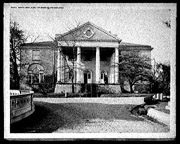The Woodlands
 |
| For notables of the time, a stop at The Woodlands was considered proper etiquette. Image courtesy Library of Congress, Prints and Photographs Division, Detroit Publishing Company Collection. |
When Meriwether Lewis visited Philadelphia in 1803, it's not unlikely that he visited William Hamilton at Hamilton's estate, The Woodlands. For notables of the time, a stop there was considered proper etiquette.
The Woodlands began as 250 acres of land on the western outskirts of Philadelphia, just up the road from what would become Bartram's Garden. The land was bought by noted lawyer Andrew Hamilton in 1734. His grandson, William, inherited the property in 1747. William was an avid botanist who also loved architecture and landscape design. During his journeys he collected and introduced on The Woodlands the first American specimens of the Ginko, Norway maple, Ailanthus, and Lombard poplar. In fact, at the time of Lewis' visit to Philadelphia, many streets were already lined with Hamilton's Lombard poplar. Hamilton also collected numerous native plants with his neighbors, the botanists of the Bartram family.
In 1784 Hamilton went to England for two years to inspect the best houses. His intention was to make The Woodlands "smile in the most beautiful and useful manner." He returned with a collection of plants, materials, and a plan. The Woodlands Mansion was the fruit of that dream.
The mansion was a magnificent example of 18th century Classical Revival architecture. Inspired by the homes created by English architect Robert Adam, the mansion features a circular interior plan of non-rectangular spaces, "secret" passages, mirrored surfaces, and classical details. Among the guests of the mansion were presidents Washington and Jefferson and Joseph Bonaparte, Napoleon's brother and the king of Spain and Naples.
Outside the mansion Hamilton built greenhouses that were home to the largest collection of plants in America. The property also featured a carriage house and stable. The Woodlands' garden landscape was developed into a rural garden cemetery in the 1840s. Among the notables buried there is Joseph Campbell, the founder of Campbell's Soup; Frank Richard Stockton, comic novelist who penned the famous short story, "The Lady or the Tiger"; Anthony Joseph Drexel, financier and founder of Drexel University; and Rufus Welch, pioneer circus showman who was the first to import giraffes to America.
The mansion and grounds today are a national historical monument.
< previous |



